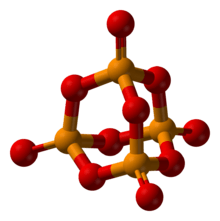Phosphate glass
Phosphate glass is a class of optical glasses composed of metaphosphates of various metals. Instead of SiO2 in silicate glasses, the glass forming substrate is P2O5.
Discovery
Dr. Alexis G. Pincus of the American Optical Company supplied aluminium phosphate glass samples for Manhattan Project-era Oak Ridge researchers, and was anecdotally called the inventor in 1945 in a Columbia University researcher's note by Aristid V. Grosse. [1]
Physical properties
P2O5 crystallizes in at least four forms. The most familiar polymorph (see figure) comprises molecules of P4O10. The other polymorphs are polymeric, but in each case the phosphorus atoms are bound by a tetrahedron of oxygen atoms, one of which forms a terminal P=O bond. The O-form adopts a layered structure consisting of interconnected P6O6 rings, not unlike the structure adopted by certain polysilicates.[2]

Phosphate glasses are highly resistant to hydrofluoric acid. With an addition of iron oxide, they act as efficient heat absorbers.
Iron phosphate and lead iron phosphate glass are alternatives to borosilicate glass for immobilization of radioactive waste.[3]
Unique properties
Phosphate glasses can be advantageous over silica glasses for optical fibers with high concentration of doping rare earth ions.[4][5]
A mix of fluoride glass and phosphate glass is fluorophosphate glass.
Silver-containing phosphate glass is used in phosphate glass dosimeters. It emits fluorescent light when irradiated by ultraviolet light, when previously exposed to ionizing radiation, in an amount proportional to the dose.[6]
Some phosphate glasses are bio-compatible and water-soluble and are suited for use as degradable tissue and bone scaffolds within the human body.[7]
References
- "Note on the use of silica-free glasses for handling anhydrous hydrogen fluoride and uranium hexafluoride". Columbia University. September 1945. Retrieved 15 February 2018.
- Karabulut M, Melnik E, Stefan R, Marasinghe GK, Ray CS, Kurkjian CR, Day DE (2001). "Mechanical and structural properties of phosphate glasses" (PDF). Journal of Non-Crystalline Solids. 288 (1–3): 8–17. doi:10.1016/S0022-3093(01)00615-9. Archived from the original (PDF) on 2016-08-05.
- "Iron Phosphate Glass as an Alternative Waste-Form for Hanford LAW" (PDF). Pacific Northwest National Laboratory. February 2003. Retrieved 22 March 2010.
- Rüdiger Paschotta. "Silica Fibers". Encyclopedia of Laser Physics and Technology. RP Photonics Consulting GmbH. Retrieved 22 March 2010.
- Karabulut M, Melnik E, Stefan R, Marasinghe GK, Ray CS, Kurkjian CR, Day DE (2001). "Mechanical and structural properties of phosphate glasses" (PDF). Journal of Non-Crystalline Solids. 288 (1–3): 8–17. doi:10.1016/S0022-3093(01)00615-9.
- "Phosphate glass dosimeter". European Nuclear Society. Retrieved 22 March 2010.
- Bitar M, C Knowles J, Lewis MP, Salih V (December 2005). "Soluble phosphate glass fibres for repair of bone-ligament interface". Journal of Materials Science: Materials in Medicine. 16 (12): 1131–6. doi:10.1007/s10856-005-4718-3. PMID 16362212.
External links
- "Chemically Bonded Phosphate Ceramic – an overview | ScienceDirect Topics". sciencedirect.com. Retrieved 11 July 2020.